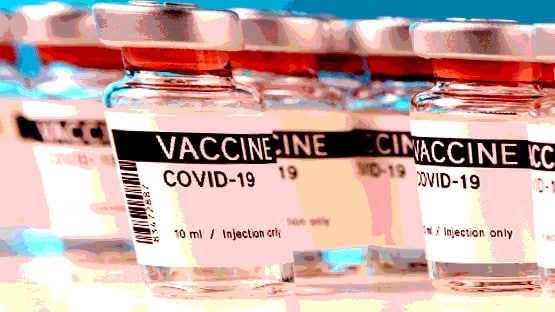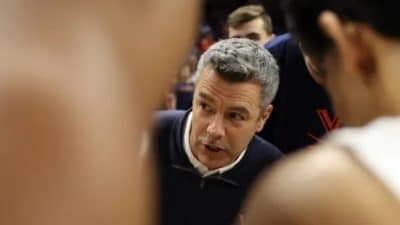
– stock.adobe.com)
We had our chance to get COVID under control, right after the vaccines arrived in late 2020, and began to be disseminated widely in the first few months of 2021.
The reason we didn’t: the misinformation from politically-motivated vaccine skeptics that continues today, three and a half years into the pandemic.
We never did get to the magic 90 percent vaccination number that epidemiologists had set as the goal to try to get transmission in check.
As of this past May, the CDC, in its final national update, reported that 81.4 percent of Americans had received at least one vaccine dose.
That’s May 2023 – more than two years into the COVID vaccine era.
Congrats, Aaron Rodgers, RFK Jr., Joe Rogan, the rest.
Because of you, COVID is here to stay.
“Part of the push for the 90 percent vaccination was to really get the rate of transmission below what we call one, the reproductive rate, and having a single person who’s infected infect fewer than one other person, and so that was the push for that, because then the virus would have probably died out, not been a problem,” said Lisa Lee, associate vice president for research and innovation, and director of the division of Scholarly Integrity and Research Compliance, at Virginia Tech.
For the Rodgers, RFK Jr. and Rogan I do my own research types reading this, Lee is the real deal – an epidemiologist, bioethicist and ethics educator, she served as the inaugural Chief of Bioethics at Walter Reed Army Institute of Research, during the Obama administration, served as executive director of the Presidential Bioethics Commission, and for more than 25 years, Lee has worked in public health and ethics at the local, state, and federal levels, including 14 years at the U.S. Centers for Disease Control and Prevention.
I get it – that probably makes her too qualified, part of the conspiracy to get everybody jabbed so that the government can track us.
For the rest of us, who live in the real world, the notion that was popular and motivating in late 2020 and early 2021, the idea that mass vaccination would help us “nip COVID in the bud,” as Lee told us in an interview last week, is a “horse that is out of the gate,” Lee said.
“And so, as they say, here we are,” she said.
Where we are right now is the lull between COVID waves. The late-summer surge peaked in Virginia with the Virginia Department of Health reporting a seven-day average of 1,038 new COVID cases per day on Sept. 12.
The seven-day average of new cases in Virginia is down more than 30 percent from that peak, sitting at 651 cases per day as of the day of publication of this report, Thursday, Nov. 2.
COVID ebbs and flows in line with how other respiratory illnesses ebb and flow – with smaller peaks in the summer when people are inside more to escape the heat with air conditioning, and bigger peaks in the winter with more people inside for longer periods to escape the cold.
We all remember the peak from the early winter of 2021-2022, which saw daily COVID case totals in the 20,000-plus range in mid-January just in Virginia, as the vaccines were in the early stages of dissemination.
From that unfathomable-to-us now peak, the 2022-2023 winter surge topped out in the first week of January, with cases in the 2,500-per-day range in Virginia.
That’s still significant, and the news here is, we could be headed back in that direction in the next few weeks with the arrival of cold weather.
“People often say, does the virus know that it’s winter?” Lee said. “I mean, we don’t know exactly why these things are worse in winter, but what we do know is that we spend a lot more time inside in winter, we gather in groups, schools, football games, these other kinds of things, and in that, we’re closer to each other, and that’s how the viruses spread, is breathing close to each other.”
Even with COVID relatively under control, certainly in comparison to the 2020-2021 peaks, COVID is still killing around a 1,000 people per week just in the U.S.
And it’s not just going to go away.
“I think it’s fair to say we’re going to be living with COVID for quite some time,” Lee said. “What we saw is what we usually see with any new infectious disease, we see a huge peak and a lot of death and a lot of illness, and then as the population begins to build some immunity, either through a vaccine or through having had it had COVID, we’re getting more used to it, so to speak, as our immune systems are starting to protect us as they’re designed to.
“I think what we’ll see from now on is these waves of COVID that will likely follow what we see with other respiratory diseases like RSV, also like influenza or flu. We’ll see the these waves because the virus that causes COVID transmitted in the same way the virus that causes flu and other respiratory problems.”
I was asked by a friend the other night at a Halloween party if it is still important to get COVID shots. The answer from Lee: an unequivocal yes.
“We need to do what can we do to keep these numbers as low as possible,” Lee said. “I think what we can do are the things we’ve talked about all along, which are, if you can get vaccinated, do get vaccinated, even if you think that you’re healthy, and you had COVID once, and it was no big deal, you know, all that’s fine and good for you. But if you’re around anyone who might not have the luxury of a strong, robust immune system, that is, anyone who’s older, younger, or who has a challenge, is immunocompromised in any way, then, you know, if you don’t do it for yourself, do it for the people you’re around. So, I think that’s one thing. Get vaccinated, if you can.”
The other things are basic things all of us can do.
“You know, don’t cough or sneeze around other people. If you’re sick, stay home from work, if you have a fever, don’t go out and be with other people. That fever might be COVID, it might be the flu, it might be RSV, who knows, but why risk infecting someone else?” Lee said. “And then the other thing that that we talked about, you know, if you’re having any kind of symptoms, stay away from other people as much as you can. And that includes not going out, but also basic things like washing your hands and, you know, coughing and sneezing into your elbow or a tissue or something like that. So, too, basic infection control hygiene would be highly recommended, in addition to the vaccine.”
One other basic thing we can all do: be respectful of people who decide to mask up.
“We see people out and about, at least have I have of late, wearing masks, I mean, not certainly the number that did in the beginning, but there are people who either are immunocompromised and really don’t want to get anything, so they wear a mask. Part of what we can do as a community is be respectful of that, and let people take care of themselves,” Lee said.
“I think that’s the other thing that’s such an important message for all of us now is, it doesn’t mean a person sick, it doesn’t mean anything except the person is either protecting themselves or other people. And let’s celebrate that and not criticize that. So, I think part of it is, you know, being respectful of the fact that people will do what they need to do to take care of their health, and we should be celebrating.”
The bottom line message from Lee, as the first cold snap of the fall of 2023 is upon us: “just be vigilant this time of year.”
“When spring comes, and we get outside again, it’ll be just like always, we’re outside, and the transmission decreases pretty dramatically, we feel lucky and happy, that’s great. But for these next few months, be vigilant to be careful and respect other people who are trying to do the same,” Lee said.










